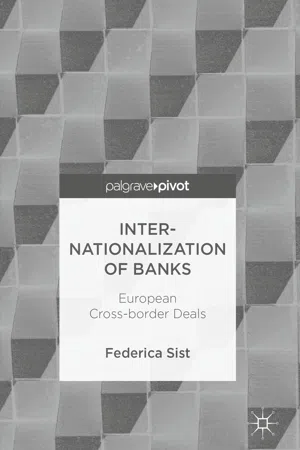Abstract
This chapter analyzes why banks internationalize. This activity should be developed through certain forms, implying that banks undertake activities abroad in several ways: by themselves or alongside other partners, within the form of an equity or non-equity deal. A bank can do so in order to follow domestic clients operating in foreign markets, to expand markets, to increase profit or to take advantage of different regulatory systems. If the decision to internationalize requires a high degree of penetration, the strategy selected for entering the market or consolidating its position will consequently require a higher involvement in ownership, resources and risks. Branches and subsidiaries are ways to internationalize with high involvement through both non-equity and equity deals (joint ventures, minority or majority acquisitions) or through Greenfield. The reconnaissance of literature helps to understand the opportunities available to banks.
1.1 Introduction
The internationalization of the banking sector is a topic that has been the focus of many inquiries, yet it does not receive much attention in the existing books. McCauley et al. (2010) noted the increasing trend of bank internationalization , arousing interest in banks’ behaviour. From the literature emerges the need to investigate in greater depth the two-part question that will be addressed in this chapter: why and how do banks go abroad? The topics can be dealt with from different points of view, depending on the definition of internationalization that is adopted. The definition has to be closely connected with the method for evaluating the degree of internationalization of a bank, or for recognizing a bank as internationalized. Certainly, the international diversification of the ownership of banks , with an increase in cross-border transactions replacing cross-border flows, contributes to the involvement of banks in foreign activities (Goldberg 2009). The Bank of International Settlement (BIS) offers a wider measure of the internationalization of a commercial bank through a bank’s cross-border assets and liabilities. Therefore the bank is defined as internationalized if has activities abroad.
The following section aims to explain the various reasons why a bank expands its activity or ownership abroad. The section after describes the different options that a bank should consider when entering a foreign market and the models available for its international business, which are different in some aspects for the international bank. Finally, the advantages of equity and non-equity deals with local partners in order to enter the foreign market are described.
1.2 Why Do Banks Internationalize?
While the debate in the literature focuses on whether or not banks benefit from internationalization, the real question is whether banks can avoid having links with foreign markets. In the new paradigm of globalization there is a combination of benefits from certain markets th...
